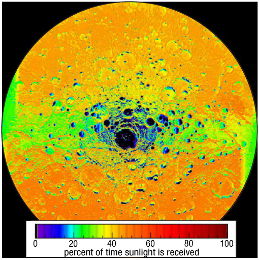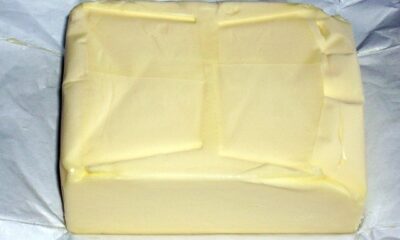Creation Corner
Mercury ice must have come from earth

Almost everyone agrees that comets and water-rich asteroids delivered lots of ice to Mercury. But the Mercury ice must have come from Earth. It cannot have come from anywhere else.
Where did comets come from?
Oort Cloud Theory, original and revised
Ask most people where comets came from, and they’ll usually answer: “the Oort cloud.” In 1950, Jan Oort proposed that all comets formed in a “cloud” that surrounds the Sun. Conveniently, Oort placed this cloud 50,000 times further away than the Earth is from the sun. That’s further out than anyone could see. Modern astronomers see the cloud as a uniform sphere with the Sun at its center. (Oort JH, “The Structure of the Cloud of Comets Surrounding the Solar System, and a Hypothesis Concerning Its Origin,” Bulletin of the Astronomical Institutes of the Netherlands, Vol. 11, No. 408, 13 January 1950, pp. 91–110. Cited here.)
According to Oort, these objects formed 4.5 billion years ago, when the Earth formed. Passing stars perturb the orbits of these objects, and send some of them careening into the inner Solar system. Later astronomers proposed that the Oort cloud lies closer in than 50,000 Astronomical Units (AU). (The Earth is 1 AU from the Sun.)
Other conventional theories
Surprise! Jan Oort isn’t the only one with a theory to explain the comets. Why not? Because much of what we see when we look at comets includes several “deal-killers.” Even the revised Oort cloud theory, though it solves some problems, creates others. So scientists have not settled on one theory of where comets came from. They have at least four more:
- A fifth rocky world, between Mars and Jupiter, blew up. Some of its stuff became the asteroid belt. The rest became the comets.
- The gas giants (Jupiter, Saturn, Uranus, Neptune) have volcanoes that belch out the stuff of comets.
- Comets form from meteor streams that capture water vapor.
- The sun passes through interstellar dust clouds. It captures some of the dust. That dust condenses to form comets.
Each theory above has one thing in common with the rest. The events it describes happened millions of years ago, or billions.
Hydroplate Theory
Walter T. Brown Jr. has his Hydroplate Theory. According to it, the earth once had a ten-mile-thick crust, with a 3/4-mile-deep subcrustal ocean deep to this. 4400 years ago, the crust cracked open. All that water rushed out, some so fast it escaped into space. (And carried a lot of rock and mud with it.) But before that, this water absorbed many neutrons. (The cracked crust shook hard, in magnitude-10-to-12 earthquakes. This was strong enough to form radioactive elements! It also produced a lot of neutrons.) That’s why most comets are rich in heavy water (D2O and HDO). These comets shot off in all directions. Most fell to earth, or the Moon, Mars, and Mercury, in the first few centuries after the Global Flood. (The ancient Greeks saw them fall often, and called them dysastroi, or evil stars – whence disaster in modern English. A comet might have heralded the birth of Moses.)
As the water, rock and mud flew further out from earth, these rocks would form spheres of influence that would grow larger and draw in water. (Brown points out that the Apollo 13 astronauts watched as their “toilet jetsam” would “orbit” their spacecraft all the way to the Moon and back!) Comets, asteroids, and meteoroids all formed this way.
Comets and the Mercury Ice

Map of Mercury’s south pole, showing how often each part of the surface is in the sun. The dark purple regions are always in shadow. That’s where the MESSENGER probe found the Mercury ice. Graphic: NASA, reprinted in In the Beginning: Compelling Evidence for Creation and the Flood by Walter T. Brown. Used by permission.
What has this to do with the Mercury ice? Plenty. For the Hydroplate Theory can explain the Mercury ice (and the lunar ice, and the Martian ice) easily. To quote Brown:
How could so many comets have recently hit the Moon and planet Mercury that ice remains today? Ice on the Moon, and certainly on hot Mercury, should disappear faster than comets deposit it today. However, if the material that formed 50,000 comets were ejected recently from Earth and an “ocean” of water vapor was injected into the inner solar system, the problem disappears. On Mars, comet impacts created brief saltwater flows, which then carved “erosion” channels.
So the Mercury ice fits neatly into the Hydroplate Theory. But: for any other theory, the Mercury ice is a deal-killer. Why? Remember: whatever else conventional scientists say happened, happened millions of years ago at least. The Mercury ice, and the lunar ice, should have sublimated away by now. Yet MESSENGER found enough ice to bury Washington, DC in two and a half miles of ice. That much ice should not be there. Yet there it is. NASA knew it was there twenty years ago. MESSENGER confirmed it.
Now it is all very well to say, as a near-apoplectic commenter said to this writer in the last twenty-four hours,
Yes Terry, [Walt Brown did show that the Mercury ice is a deal-killer for every theory but his own.] But he’s WRONG! The universe is full of ice. Water is the second most common molecule after molecular hydrogen. There’s ice everywhere.
That this ice formed is not the issue. The issue is that the Mercury ice is still there, on the innermost and hottest planet in all the Solar system, after an alleged millions of years have passed. How it got there is easy to explain. Why it stayed there is not so easy.
The Mercury Ice confirms a recent origin
Thus the Mercury ice must have fallen thousands, not millions (and certainly not billions), of years ago. That also confirms a recent origin for the comets. (And the asteroids, too.) Only one event as recent as that could have produced that much water to fall and freeze in the craters of Mercury. That event was the Global Flood.
The MESSENGER project scientists will almost certainly deny what the Mercury ice implies. But they cannot, nor do they want to, deny the Mercury ice itself. This is the most exciting recent find to date from NASA’s deep space program, though for reasons NASA’s bosses would never guess.
ARVE error: need id and provider
[subscribe2]
Terry A. Hurlbut has been a student of politics, philosophy, and science for more than 35 years. He is a graduate of Yale College and has served as a physician-level laboratory administrator in a 250-bed community hospital. He also is a serious student of the Bible, is conversant in its two primary original languages, and has followed the creation-science movement closely since 1993.
-

 Civilization5 days ago
Civilization5 days agoOn the 2025 National Security Strategy
-

 Civilization3 days ago
Civilization3 days agoIvory Tower Thinking and Narcotics Boats
-

 Executive2 days ago
Executive2 days agoThe Last Supper: New York’s Socialist Feast
-

 Civilization2 days ago
Civilization2 days agoYoo Hoo, VP Vance—Your Character is Showing!
-

 Executive4 days ago
Executive4 days agoWaste of the Day: Shockingly, Inmate Phone Calls Lead to More Criminal Activity
-

 Civilization5 days ago
Civilization5 days agoIf Not a Musk, Then the Navy Needs Another Rickover
-

 Executive4 days ago
Executive4 days agoWH Ignores Demands From Pro Life Lobby To Fire FDA Commissioner
-

 Executive3 days ago
Executive3 days agoWaste of the Day: Throwback Thursday – Funding Fat-Filled Butter













David Sullivan liked this on Facebook.
[…] Reprinted from Conservative News and Views Your email: Share this:EmailPrintFacebookLinkedInStumbleUponTwitterTumblrRedditGoogle +1 This entry was posted in News by Terry Hurlbut. Bookmark the permalink. […]
“The Mercury ice, and the lunar ice, should have sublimated away by now.”
Can you let me know how you have calculated this? What temperatures you assume for the shaded polar craters of Mercury, what the geometry of the ice there is, what the purity of the ice is, that sort of thing? Because 2007 calculations based on sublimation rate experiments in 1981 and 2005 suggest that for pure ice in a flat sheet, sublimation rates at 70K are only one molecule of water per hour per square centimeter. Temperatures below 70K result in a logarithmic drop in sublimation rates: from 70 to 40K results in sublimation rates dropping by 25 _orders of magnitude_. Dirty ice sublimates more slowly still, since surface sites are occupied by non-ice molecules or particles. For a square meter of pure, flat ice at 70K, to sublimate 1 mole of water ice (18g) would take (6.02e23mol/mole)/((1molecule/cm^2*hr)(1000cm^2/m^2)) = 6.02e20 hours, or ~7e16 years. If the ice is dirty or colder than 70K (one of the NYT articles suggests 50K) it would be even slower. What does your calculation suggest instead?
You want to take that one up with Dr. Brown? He still has his written and conference-call debate offers on the table.
“You want to take that one up with Dr. Brown? He still has his written and conference-call debate offers on the table.”
I’ll be happy to, as soon as he confirms that he won’t distribute my personal information.
Technically, I wasn’t talking to you just then. But his offers apply to everyone.
“Technically, I wasn’t talking to you just then. But his offers apply to everyone.”
Excellent. I’d like to hear Brown explain how his “theory” accounts for all the water we’ve detected in the universe.
He never said the water shouldn’t be, say, in asteroids, or among Trans-Neptunian Objects.
He said water ice should not persist on Mercury, because the comets are not resupplying it as fast as it is sublimating away. This finding falsifies the Uniformitarian Principle as applied to this case.
“He said water ice should not persist on Mercury, because the comets are not resupplying it as fast as it is sublimating away.”
Yes, but once again he’s WRONG! The sublimation rate of water has already been presented. It is rather low. The existence of water on Mercury really isn’t a puzzle. Astronomers aren’t startled or conflicted by it, just excited. It isn’t forcing anyone to revise their opinions because astronomy can account for it very easily, and has done for years. Water on Venus would be remarkable; water on Mercury isn’t.
No, a citation to Dr Brown’s calculations will be sufficient. I do not see any in the link you provided in the article, but I may have missed them. Dr. Brown would likely be more favorably disposed to providing such references to you rather than me.
The back-of-the-envelope calculation that I did, for example, was based on a 2006 (I believe I said 2007 in my previous post, which was an error) paper by Andreas, available at link to tinyurl.com or searchable online by title, “New estimates for the sublimation rate for ice on the Moon.”
[…] Mercury ice must have come from Earth […]